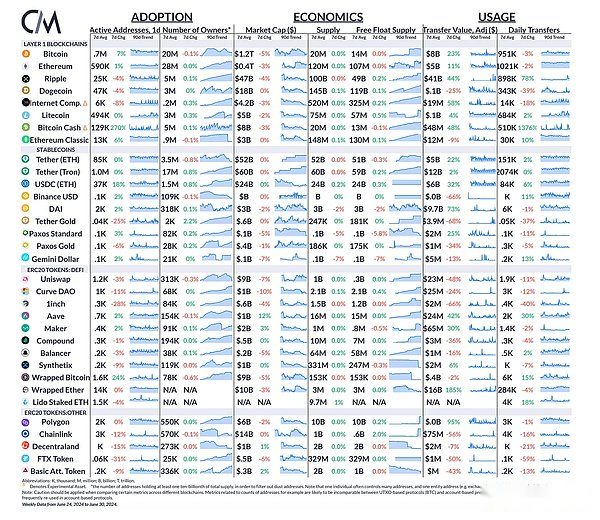
Author: Parker Merritt Source: Coin Metrics Translation: Shan Oppa, Bitchain Vision
Key points:
-
After halving, Bitcoin’s hash rate (30-day moving average) has fallen 7% from its all-time high of 626 EH/s and is currently 580 EH/s
-
OKX’s massive UTXO integration brought a brief boost to transaction fee revenue, and miners received $38 million in transaction fees in 3 days
-
Toronto-based mining machine company Bitfarms has made remarkable progress in mining machine efficiency, reducing incremental energy consumption from 35 J/TH to 27 J/TH by 2024
-
During the peak of the 2021 bull market, the Antminer S19 traded at $100/TH, and now it has traded as low as $2.5/TH on the secondary market
Introduction
This week’s “Net Status” report revisits the Bitcoin mining space, continuing our quarterly update series on proof-of-work stakeholder status.Since the Bitcoin halving in April, mining profits are under pressure due to stagnation in Bitcoin prices and a sluggish fee market, although short-term on-chain congestion periods have provided some help to alleviate revenue.Many mining companies are diversifying their businesses, not just limiting them to simply mining, but repositioning themselves as general infrastructure providers, trying to obtain hosting contracts for high-energy-consuming artificial intelligence applications.At the same time, the momentum of chip efficiency improvement has been unabated, forcing miners to consider whether to continue using old ASIC hardware or to conduct comprehensive mining machine upgrades.In this report, we will dig into each of these factors to evaluate the health of the mining industry in addition to Bitcoin price performance.
Mine integration
At first glance, the second quarter of 2024 is a relatively profitable period for Bitcoin miners.In the 18 quarters since January 2020, the quarter ranked fifth by total dollar revenue, with miners receiving a total of $3.77 billion in revenue through block subsidies and transaction fees.Of course, these earnings are in the forefront due to the halving, accounting for nearly half of the revenue this quarter in April alone.May and June are more difficult months for miners as Bitcoin block rewards dropped from 6.25 BTC to 3.125 BTC on April 20, and the popularity of the “rune” tokens faded in the following weeks.Therefore, Bitcoin’s computing power shows signs of miners’ exit – the 30-day moving average of 580 EH/s is down 7% from the record-high 6.26 EH/s.

Source: Coin Metrics Network Data Pro
Despite weakening overall revenue momentum, the unexpected increase in on-chain traffic still provides miners with some respite.In early June, the Bitcoin memory pool was filled with a large number of transactions paying high fees, and by noon on June 7, the average hourly transaction fee was as high as $945.This congestion period significantly increased mining revenue, with computing power prices (dollar revenue per TH/s per day) soaring to $0.09, and handling fees contributed more than 42% of revenue.
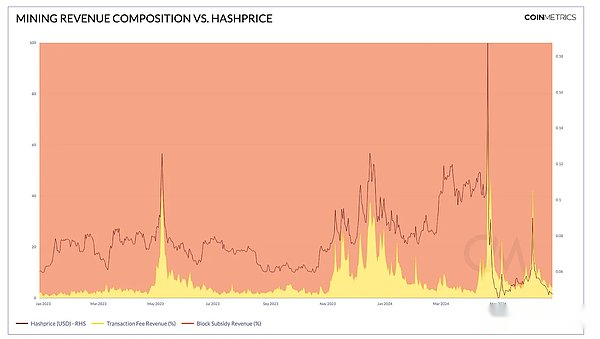
While surges in fees are often associated with token protocols like Ordinals and Runes, the recent increase in mining revenue is brought about by internal operations of a single centralized exchange.OKX (the fourth-ranked exchange by Bitcoin spot trading volume) has carried out a series of large-scale “UTXO mergers” to clear accounts by combining scattered Bitcoin shares into larger, more compact denominations.Since the fees of Bitcoin transactions depend on the block space they consume, transaction transfer costs involving many UTXOs are more expensive, while “merged” UTXOs can unlock payments with a lighter, more cost-effective on-chain footprint.
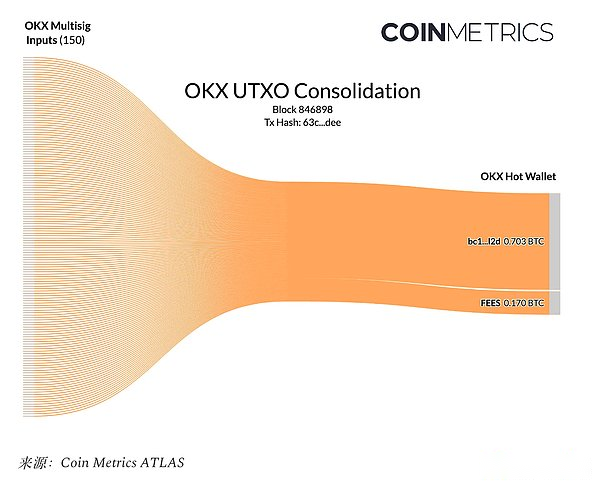
The UTXO merge process is similar to dumping a bunch of loose money into an automatic zero-change machine and then exchanging a $20 bill.However, just like a zero-changer, this service comes at a price.While daily fees usually range from around $1-2 million, miners earned nearly $38 million in revenue within 3 days of OKX’s UTXO merger.In hindsight, OKX could have performed their accounting cleanup more effectively because they paid a huge premium for quick settlements – but miners certainly won’t complain in the face of a sluggish transaction queue and record low computing power prices.
The importance of infrastructure
Since Bitcoin halving, the stock prices of most listed mining companies have fluctuated sideways with Bitcoin.Shares of the three major mining companies, Marathon Numbers (MARA), Clean Sparks (CLSK) and Riot Platforms (RIOT), failed to outperform Bitcoin in the second quarter, with only marathon companies barely achieving slight relative returns.So far, dark horses in the Bitcoin mining competition have performed best, with Core Scientific (CORZ), Iris Energy (IREN) and TeraWulf (WULF) all outperforming competitors by double-digit margins.Coincidentally, these companies have catered heavily to the AI boom, positioning themselves as energy and infrastructure providers for a wider range of computing applications.
In June, Core Scientific signed a series of multi-billion-dollar contracts with CoreWeave, a “AI supercomputing company”, agreeing to provide hundreds of megawatts of power capacity to host the company’s high-performance computing (HPC) hardware.Shortly afterwards, CoreWeave submitted a “non-solicited proposal” to Core Scientific, proposing to acquire its entire business, but Core Scientific rejected it on the grounds of its “growth prospects” and “value-creating potential.”proposal.IREN and WULF also highlight their unique positioning in hosting HPC infrastructure, which makes them attractive partners (and possible acquisition targets) for AI businesses increasingly facing energy constraints.
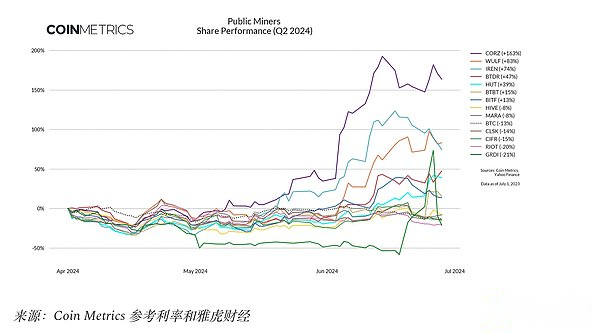
For other miners, stock price changes are mainly driven by internal mergers and acquisitions.Although small-cap mining company GRIID Infrastructure (GRDI), has lagged behind peers since its listing this year, CleanSpark announced its acquisition in June, claiming that the move will increase their power capacity by 400 megabytes in two years.watt.In May, Riot Platforms disclosed its 9.25% stake in Bitfarms (BITF), a slightly smaller mining company that is suffering from corporate governance issues.Riot proposed to acquire all stake in Bitfarms for about $950 million, claiming that the acquisition will create “the world’s largest listed Bitcoin mining company” by the end of the year.Bitfarms quickly rejected the proposal, defending against Riot’s malicious acquisition by issuing the “Poison Pill” program, which aims to dilute stakes in entities seeking acquisitions in the open market.
Riot’s motivation for acquiring Bitfarms can be attributed to several factors, but one thing worth noting is the significant improvement in their efficiency.Bitfarms has always leveraged low-cost hydropower, using older generation ASIC chips instead of upgrading to the cutting-edge hardware.This causes them to lag behind competitors in indicators such as mining machine efficiency. Mining machine efficiency is measured by “Jooles per terrestrial hash” (J/TH), representing the incremental energy consumed to generate computing power.However, Bitfarms recently implemented a comprehensive miner update, purchasing the 16 EH/s Antminer T21s (19 J/TH).In 2024, Bitfarms’ average mine efficiency increased from 35 J/TH to 27 J/TH, surpassing Riot’s stagnant 27.7 J/TH.
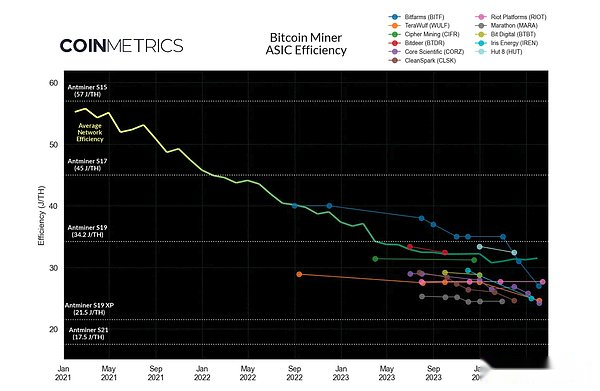
Bitfarms has achieved impressive results in improving average mine efficiency.Iris Energy has reduced average energy consumption by 15% to 25 J/TH in the past 6 months, and TeraWulf has achieved an 11% efficiency gain in the same period to 24.6 J/TH.Just out of Chapter 11 bankruptcy proceedings, Core Scientific is currently leading with 24.23 J/TH, slightly ahead of current efficiency leader Marathon Digital’s 24.5 J/TH.As the competition for optimizing operations narrows to the accuracy of decimal points, miners are now turning their attention to the next-generation ASIC chips in a bid to stand out from the competition.
ASIC Era
After more than ten years of chip manufacturing innovation, Bitcoin mining application-specific integrated circuits (ASICs) have achieved unprecedented improvements in efficiency.The first commercial ASIC chip, the Canaan Avalon 1, was launched in January 2013, with a computing power of only 0.06 TH/s.Its power consumption is 620 watts, which is equivalent to an efficiency of 10,333 J/TH.At that time, this was a big leap in the output of original computing power, with the total network computing power at that time being only 22 TH/s.Shortly after the release of Avalon 1, competitor manufacturers also actively entered the market, and continued technological advancements have led to a 14,000-fold increase in computing power in two years.
The extent of efficiency improvement has gradually decreased from early exponential growth periods, but manufacturers are still actively reducing the energy consumed by production unit computing power.In June, Bitmain announced its latest Antminer S21 XP series model, with a water-cooled version with a computing power of 473 TH/s and an efficiency of 12 J/TH.Although Bitmain is still a giant in the industry, emerging manufacturers like Bitdeer (led by former Bitmain CEO Wu Jihan) have announced that they will produce 5 J/TH ASICs in the second quarter of 2025Ambitious plan for chips.
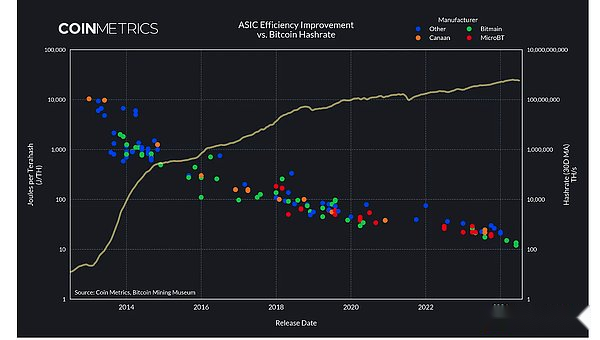
As Bitcoin miners began to phase out existing hardware fleets and switched to more efficient models, ASIC prices plummeted.While nominal prices vary by hardware specifications, ASIC traders usually quote in units of “dollar per terrestrial hash” ($/TH), providing an easy-to-comparison metric to measure premiums across various models.
The bull market in 2021 (plus China’s mining ban) has contributed to an overprofit period for BTC mining.This leads to a high premium for the Antminer S19 model (90-110 TH/s), with prices remaining highs around $90-100/TH throughout the year.However, in 2022, the revenue plunge put a huge pressure on the ASIC premium, with the S19 price falling by more than 80%.Secondary markets such as Kaboomracks continue to surrender after the halving, with the poorly performed S19 model trading as low as $2.5/TH in June.
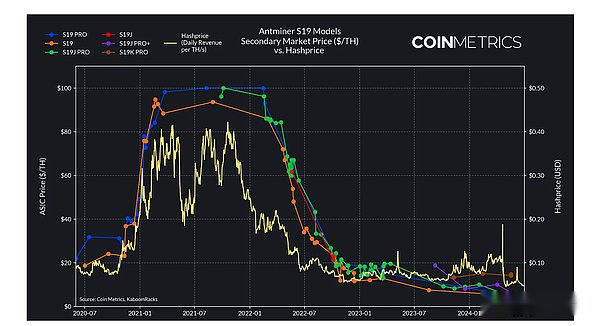
Despite losing the glory of the new generation, ASIC fingerprinting technology shows that the S19 series still contributes over 50% hash rate, indicating that they are being redeployed to lower-cost sites rather than being fully retired.Even the 2016 Antminer S9 holds a foothold on the edge of the grid, and it still reliably converts waste energy into electronic cash nearly a decade after its debut.While the most efficient operators will undoubtedly choose to swap their miners for the latest models, the modern Bitcoin mining ASIC’s rugged and highly industrialized form factor ensures that almost every machine will eventually find itself in the Proof of Work ecosystem.a place for a place.
in conclusion
Bitcoin’s fifth era may be characterized by integration, with well-funded miners acquiring assets from less efficient operators.The AI industry also envys the industry’s unique energy infrastructure, and many listed miners have successfully adopted a more general data center strategy.Others remain focused on Bitcoin, viewing HPC juggling as a temporary pastime.In any case, to survive under the impact of increased efficiency and competitive pressures, all miners must turn their attention to the future, and the long-term trend of BTC prices remains an unpredictable investment in highly capital-intensive business models.
Network data insights
Summary indicators
